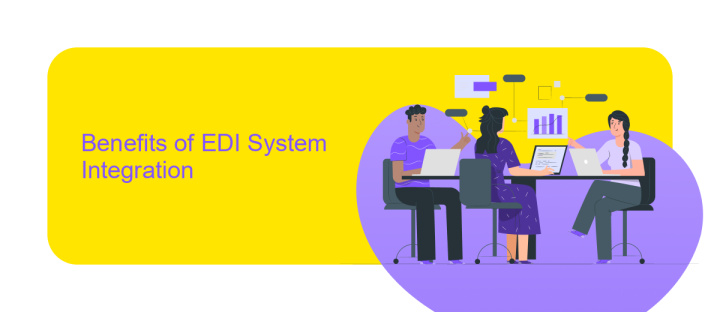Electronic Data Interchange System Integration
Electronic Data Interchange (EDI) system integration is revolutionizing the way businesses exchange information. By automating data transfer between different organizations, EDI eliminates manual processes, reduces errors, and accelerates transaction times. This article explores the benefits, challenges, and best practices of EDI system integration, offering valuable insights for companies looking to streamline their operations and enhance their competitive edge in a fast-paced digital landscape.
Introduction
Electronic Data Interchange (EDI) is a crucial technology for businesses seeking to streamline their operations and improve efficiency. By automating the exchange of business documents between partners, EDI reduces the need for manual data entry, minimizes errors, and accelerates transaction processing times. As companies increasingly adopt digital solutions, integrating EDI systems with existing IT infrastructure becomes essential for maintaining competitive advantage and ensuring seamless communication.
- Automated data exchange reduces manual entry and errors.
- Faster transaction processing improves business efficiency.
- Seamless integration enhances communication with partners.
Successful EDI system integration requires careful planning and execution. Businesses must evaluate their current processes, select appropriate EDI software, and ensure compatibility with trading partners' systems. Additionally, ongoing monitoring and support are vital to address any issues that may arise and to keep the system running smoothly. By effectively integrating EDI systems, companies can achieve significant operational improvements and foster stronger relationships with their business partners.
Benefits of EDI System Integration

Integrating an Electronic Data Interchange (EDI) system offers numerous benefits for businesses. One of the primary advantages is the significant reduction in manual data entry, which minimizes errors and accelerates transaction processing. This leads to improved accuracy and efficiency in business operations, allowing companies to streamline their workflows and reduce operational costs. Additionally, EDI integration enhances data security by ensuring that sensitive information is transmitted through secure channels, thus protecting against data breaches and unauthorized access.
Another key benefit is the ability to facilitate real-time communication and collaboration between trading partners. This fosters better relationships and enables quicker decision-making. Services like ApiX-Drive can further enhance the integration process by providing automated solutions that connect various business applications seamlessly. With ApiX-Drive, businesses can effortlessly set up and manage their EDI integrations, ensuring that data flows smoothly between systems without the need for extensive technical expertise. Overall, EDI system integration empowers businesses to achieve greater operational efficiency, security, and collaboration.
Types of EDI System Integration

Electronic Data Interchange (EDI) system integration is essential for automating business processes and ensuring seamless data exchange between partners. Different types of EDI system integration cater to various business needs and technological environments. Understanding these types can help organizations choose the most suitable solution for their operations.
- Direct EDI Integration: This method involves a direct connection between the business's internal systems and the EDI system. It is ideal for large organizations with high transaction volumes.
- EDI via VAN: Value-Added Networks (VANs) act as intermediaries, facilitating data exchange between partners. This method is beneficial for businesses that require additional services like data translation and security.
- Web EDI: This approach uses web-based interfaces for EDI transactions, making it accessible for small to medium-sized businesses without extensive IT infrastructure.
- Cloud-based EDI: Leveraging cloud technology, this integration offers scalability and flexibility, allowing businesses to manage EDI operations without significant hardware investments.
Choosing the right type of EDI system integration depends on factors such as transaction volume, budget, and specific business requirements. By evaluating these aspects, organizations can implement an EDI solution that enhances efficiency and streamlines their operations.
Implementation of EDI System Integration

Implementing an Electronic Data Interchange (EDI) system requires careful planning and execution. The first step involves a thorough assessment of current business processes to identify areas where EDI can bring improvements. This ensures that the integration aligns with the company's operational goals and maximizes efficiency.
Once the assessment is complete, the next phase is selecting an appropriate EDI solution. This involves evaluating different EDI software providers, considering factors such as compatibility with existing systems, scalability, and cost. A detailed implementation plan should be developed, outlining timelines, responsibilities, and resources required.
- Conduct a business process assessment
- Select an EDI solution
- Develop an implementation plan
- Configure and test the EDI system
- Train staff on the new system
After the EDI system is configured and tested, it is crucial to provide comprehensive training to the staff. This ensures that all users are familiar with the new processes and can effectively utilize the system. Continuous monitoring and periodic reviews should also be conducted to ensure the system operates smoothly and meets business objectives.
- Automate the work of an online store or landing
- Empower through integration
- Don't spend money on programmers and integrators
- Save time by automating routine tasks
Best Practices for EDI System Integration
Effective EDI system integration requires meticulous planning and execution to ensure seamless data exchange between trading partners. Begin by conducting a thorough analysis of your current systems and identifying key areas for integration. Establish clear objectives and define the scope of the integration project. Utilize robust middleware solutions to facilitate communication between disparate systems, ensuring data accuracy and consistency. Additionally, prioritize security measures to protect sensitive information during transmission.
Leverage tools like ApiX-Drive to streamline the integration process. ApiX-Drive offers a user-friendly interface and pre-built connectors that simplify the setup of EDI integrations without extensive coding. Regularly monitor and test the integrated systems to identify and resolve any issues promptly. Maintain comprehensive documentation of the integration process and update it as necessary to reflect any changes. By following these best practices, organizations can achieve efficient and reliable EDI system integration, enhancing operational efficiency and fostering stronger partnerships.
FAQ
What is Electronic Data Interchange (EDI) System Integration?
How does EDI System Integration benefit businesses?
What types of documents can be exchanged through EDI?
How can I implement EDI System Integration in my business?
What are some challenges of EDI System Integration?
Time is the most valuable resource for business today. Almost half of it is wasted on routine tasks. Your employees are constantly forced to perform monotonous tasks that are difficult to classify as important and specialized. You can leave everything as it is by hiring additional employees, or you can automate most of the business processes using the ApiX-Drive online connector to get rid of unnecessary time and money expenses once and for all. The choice is yours!


